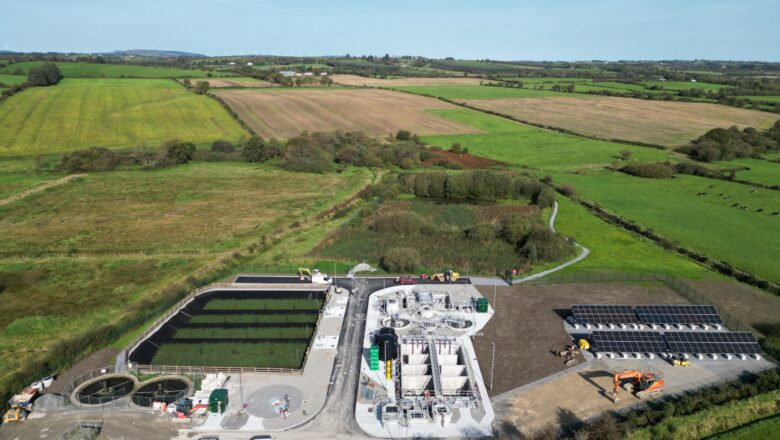Today is World Water Day, a day to recognise the importance of water in our lives and the need to preserve our most important natural resource. At Glanua, every day is World Water Day! We are committed to ensuring access to clean water and sustainable wastewater treatment for communities across Ireland and the UK, 365 days a year.
We produce an impressive 130 million litres of clean water per day in the 50 Live Water Treatment Plants we operate, while the Wastewater Treatment Plants and Pumping Stations we operate meet the needs of 60,000 people.
We understand the importance of providing essential services without interruption. Our work provides the entire spectrum of water and wastewater treatment, from design and construction to operation and maintenance, ensuring that communities receive these vital services 365 days a year.
In recent months when Storms Isha and Jocelyn disrupted essential services across the country, Glanua’s Operations Team rose to the challenge, putting their shoulders to the wheel to maintain service continuity. They worked tirelessly deploying generators and clearing debris to ensure the provision of clean and safe drinking water and effective wastewater treatment to local communities.
Amidst our daily operations, Glanua is continuously seeking out new and sustainable solutions to enhance operational efficiency, reduce environmental impact, and maximise the benefits for the communities we serve.
A recent testament to this commitment is the design and development of the Boherbue Wastewater Treatment Plant in Co Cork.
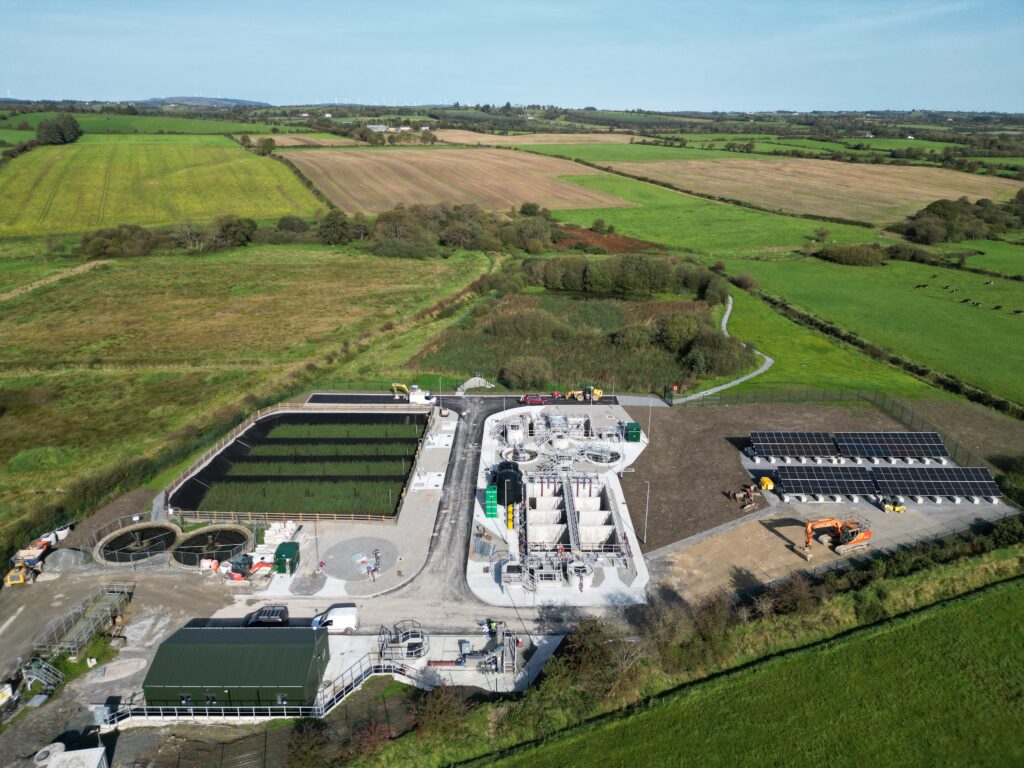
Sustainability By Design: Boherbue Wastewater Treatment Plant
The village of Boherbue in North West Cork, Ireland, has experienced significant growth in recent years, accompanied by increased housing needs. The existing wastewater infrastructure in the village was overloaded and outdated and the effluent did not consistently meet the standard required by the EPA licence.
In response to these challenges, Glanua was contracted to design and build a new Wastewater Treatment Plant (WWTP) on behalf of Uisce Eireann (Irish Water), under the Early Contractor Involvement (ECI) programme. The project aimed to address the overloaded and outdated infrastructure, ensuring compliance with regulatory standards while meeting the community’s growing needs.
Glanua’s vision, encapsulated in our tagline ‘for a cleaner planet’ reflects our commitment to environmental stewardship and the protection of natural capital. We strive to ensure our engineering solutions not only provide robust and innovative water and wastewater infrastructure but also improve the environment and limit the effects of climate change. Our approach for Boherbue concentrated on using cutting-edge and environmentally friendly technologies to lower carbon emissions and protect natural ecosystems, making it one of Ireland’s most environmentally friendly wastewater treatment facilities.
Key features of the upgraded facility included new inlet works, a stormwater tank, biological treatment processes and tertiary solids removal systems. By leveraging the Early Contractor Involvement framework, the project aimed to reduce carbon emissions through the integration of solar energy, the implementation of natural sludge drying reed beds, and the preservation of existing constructed wetlands for stormwater overflow. This comprehensive approach set a new standard for sustainable wastewater treatment, ensuring long-term environmental benefits for Boherbue, and its natural capital and serving as a model for future projects in the wastewater sector.
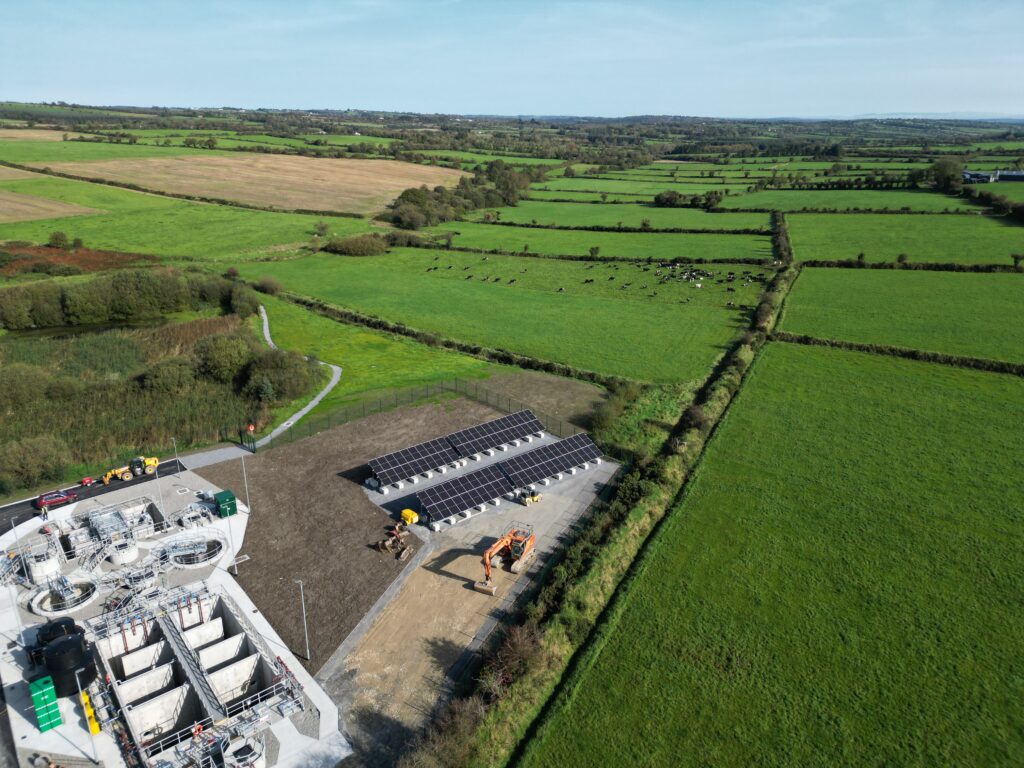
Project Delivery
The initiative was delivered under the collaborative Early Contractor Involvement (ECI) framework, representing a novel approach in wastewater treatment plant design aimed at reducing carbon emissions. This innovative delivery model, introduced by Uisce Eireann (Irish Water) originally in 2019, fosters engagement with contractors from project inception, promoting collaboration and efficiency throughout the project lifecycle.
Key principles of the ECI approach include enhanced collaboration between contractor and client, adoption of a commercial pain/gain mechanism, and appropriate risk allocation, ensuring greater cost certainty and minimising inefficiencies associated with traditional tendering processes. This delivery model also meant we could involve the local community early in Boherbue to ensure our design was meeting their needs.
The project used cutting-edge technology, including solar technology and natural sludge drying reed beds, to enhance sustainability while reusing existing constructed wetlands, using natural materials like native plants, trees, soil, sand, and stones to preserve vital habitats for a wide range of animals and plant life.
The ECI delivery model made it possible for the initial application to receive planning permission upon first application, highlighting the effectiveness of our design process and robustness of the solution in meeting the EPA’s stringent standards.
The construction of Sludge Drying Reed Beds (SDRBs) commenced in early February 2023, incorporating earth embankments and precast concrete wall sections for formation. Each cell was meticulously lined to ensure water tightness, with feed and drainage pipework installed for optimal functionality. Reeds were planted in late April to establish and grow during the summer months, aided by the importation of sludge to promote growth. This comprehensive approach ensures the effectiveness and sustainability of the SDRBs in treating wastewater and reducing the carbon footprint of the Boherbue WWTP.
In addition to the innovative technologies like solar panels and natural sludge drying reed beds, the initiative also benefited with the use of existing assets by integrating constructed wetlands (ICW) for screened stormwater overflow into the overall solution.
By integrating initiatives to protect natural habitats, utilise renewable energy sources, and reduce carbon emissions, the initiative exemplifies a successful shift in wastewater treatment plant delivery. Through early contractor involvement, the project was delivered on time and budget and is now recognised as one of Uisce Eireann’s most sustainable wastewater plants in Ireland.
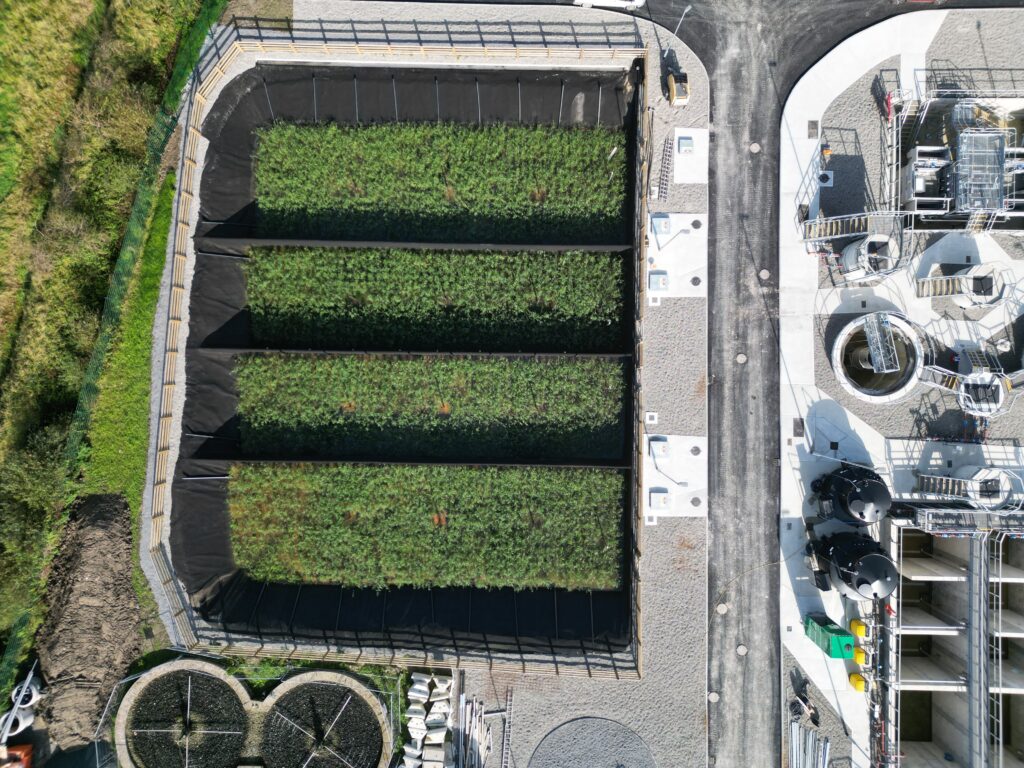
Innovation
The innovation behind this project lies in its comprehensive integration of advanced treatment processes and renewable energy solutions, surpassing conventional wastewater treatment solutions. By combining a new biological treatment process and tertiary solids removal with the incorporation of sludge drying reed beds and a solar panel farm, and reuse of the existing constructed wetlands, the project adopts a multifaceted approach to enhance sustainability and reduce carbon emissions.
One key innovation is the implementation of Sludge Drying Reed Beds (SDRB), which significantly increases sludge concentration to up to 40% Dry Solids (DS) after 10 years of operation. This revolutionary approach reduces sludge export volumes by more than tenfold compared to conventional methods, thereby minimising transportation and dewatering costs while substantially reducing the carbon footprint of the Boherbue WwTP. SDRB sludge can also be directly land spread without the need for additional chemical conditioning, further enhancing its environmental benefits.
The use of solar technology underscores the project’s commitment to renewable energy sources, contributing to further reductions in carbon emissions. By leveraging these innovative technologies and practices, the initiative sets a new standard for sustainable wastewater treatment, offering a replicable model for other treatment plants to follow. This holistic approach not only improves operational efficiency but also promotes environmental stewardship, paving the way for a cleaner and more sustainable future in the wastewater sector.
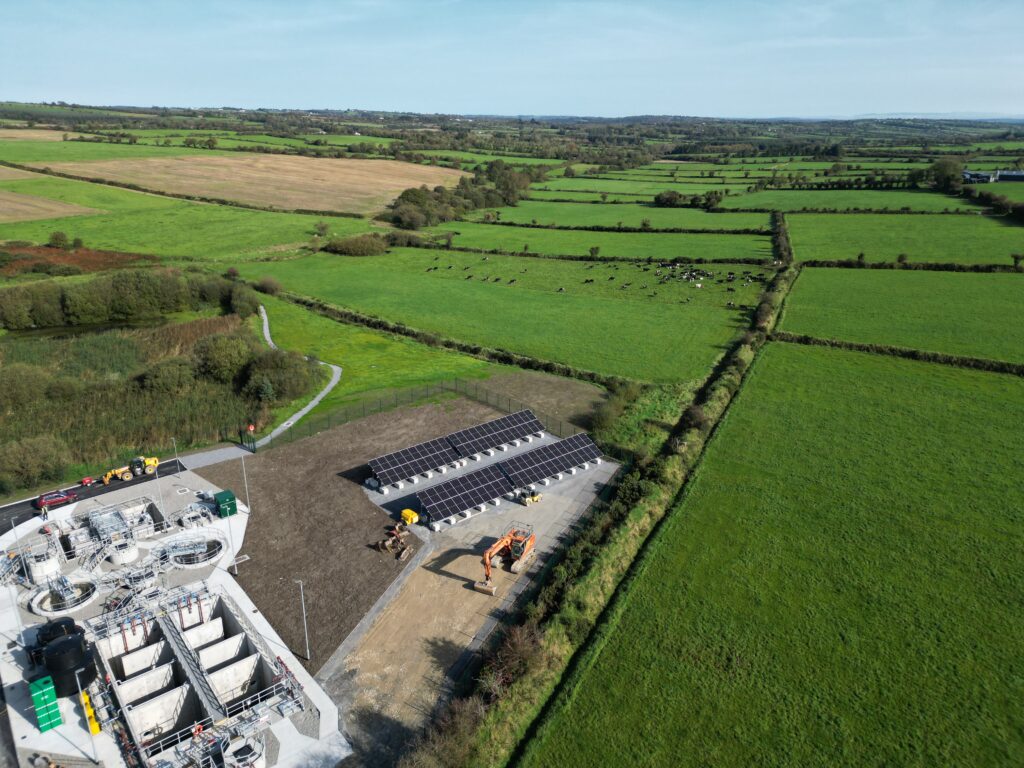
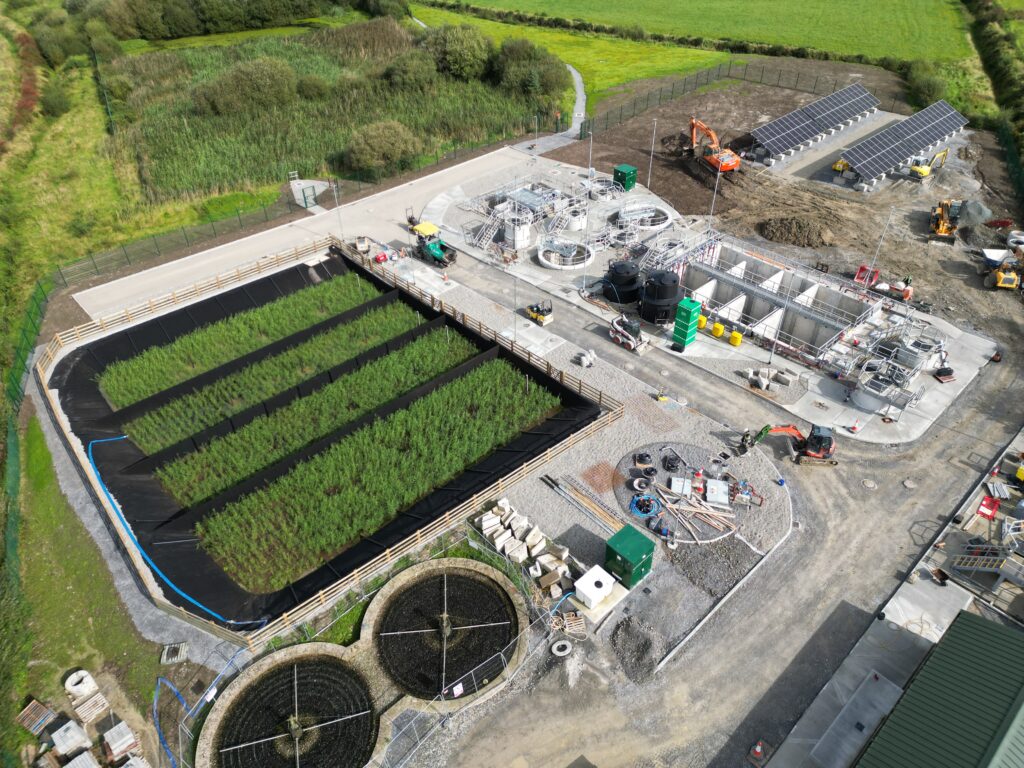
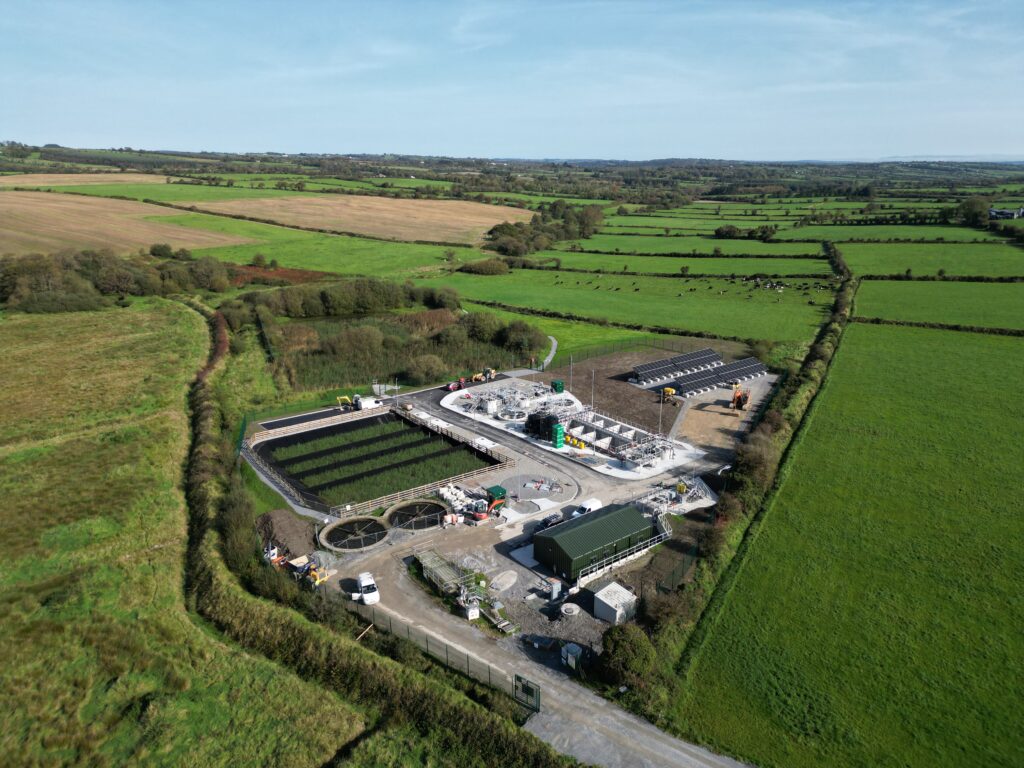
Benefits
The primary financial, customer and environmental benefits that have been achieved by the construction of Boherbue WWTP, are through the inclusion of the Sludge Drying Reed Beds, the usage of solar technology and the integration of the existing constructed wetlands for stormwater overflow.
50Kw Solar panels have been installed which will produce 42,500Kwh of electricity per year. This alone will introduce a carbon saving of 13.7T/CO2 per year which shows significant savings versus a traditionally built wastewater treatment plant of this kind.
There are numerous benefits in the inclusion of the Sludge Drying Reed Beds vs traditional sludge management practices. These include but are not limited to the following;
- Reduction of carbon footprint of the plant by approximately 45T over a 10-year period.
- Carbon capture via natural plant growth
- Up to 25% organic matter removal due to mineralisation
- Dewatering process completed with zero energy consumption
The integration of the existing constructed wetlands into the wastewater treatment facility brings a multitude of benefits, ranging from low operational costs, support for diverse ecosystems as well as sustainable water management. They also improve water quality of streams and rivers in surrounding area creating conditions for aquatic life to thrive.
Future
Boherbue WWTP upgrade works is a flagship project for sustainable and carbon saving treatment processes and will serve as a reference project for future similar projects within the industry.
Glanua has recently completed site commissioning, and are contracted to operate and maintain it for the next 12 months.
